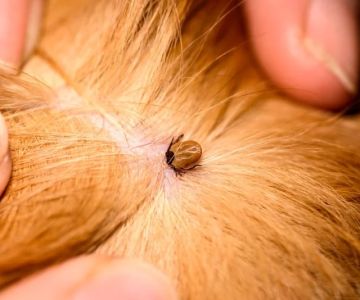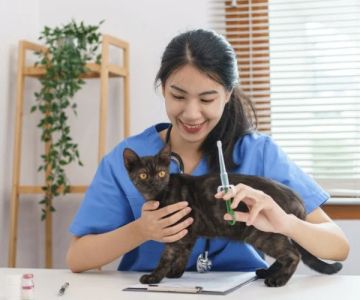
Ear Infections in Dogs: Prevention, Treatment, and Aftercare
- 1. Introduction to Ear Infections in Dogs
- 2. Common Causes of Ear Infections in Dogs
- 3. Symptoms of Ear Infections in Dogs
- 4. How to Prevent Ear Infections in Dogs
- 5. Treatment Options for Ear Infections
- 6. Aftercare for Dogs with Ear Infections
1. Introduction to Ear Infections in Dogs
Ear infections in dogs are a common health issue that can cause significant discomfort if not addressed promptly. These infections occur when bacteria, yeast, or other microorganisms invade the ear canal, leading to inflammation, pain, and discomfort. It’s essential for pet owners to understand the causes, symptoms, and treatment options available to ensure their furry friends receive the care they need.
In this article, we will explore how to identify ear infections, prevent them, and manage aftercare for your dog to ensure a healthy, pain-free life.
2. Common Causes of Ear Infections in Dogs
There are several causes of ear infections in dogs, and understanding these can help prevent recurrence. The most common causes include:
- Bacterial Infections: The most frequent cause of ear infections, bacteria such as Staphylococcus or Escherichia coli can thrive in the warm, moist environment of a dog’s ear canal.
- Yeast Infections: Fungal infections, especially from Malassezia yeast, are also common in dogs, particularly those with floppy ears or who swim frequently.
- Allergies: Allergies to food, pollen, dust mites, or other irritants can lead to chronic ear infections in dogs.
- Ear Mites: Ear mites, particularly in puppies, can cause intense itching and lead to ear infections if untreated.
- Moisture and Dirt: Dogs that swim often or live in humid environments are more prone to ear infections due to trapped moisture in their ears.
3. Symptoms of Ear Infections in Dogs
Identifying an ear infection early is crucial to prevent further discomfort and complications. Common symptoms of ear infections in dogs include:
- Head shaking or tilting: Dogs with ear infections may shake their heads frequently or tilt them to one side due to discomfort.
- Scratching or pawing at ears: Dogs will often scratch or rub their ears to relieve the itching caused by the infection.
- Odor from the ear: A foul smell from the ears, often described as musty or cheesy, is a clear indication of an infection.
- Discharge: You may notice yellow, brown, or red discharge coming from the ears, which could be a sign of infection.
- Pain or sensitivity: Dogs may show signs of pain when their ears are touched or may become agitated if the infection worsens.
4. How to Prevent Ear Infections in Dogs
Preventing ear infections in dogs involves regular ear care and addressing any underlying causes. Here are some tips to prevent ear infections:
- Regular ear cleaning: Gently clean your dog’s ears using a vet-approved ear cleaner. Be sure to dry them thoroughly afterward to prevent moisture buildup.
- Proper grooming: Regular grooming can help prevent dirt and debris from accumulating in your dog’s ears, especially for dogs with long or floppy ears.
- Control allergies: Work with your vet to manage allergies that may trigger ear infections, especially if they are linked to food or environmental factors.
- Limit moisture exposure: After your dog swims or is bathed, dry their ears thoroughly to prevent moisture from remaining in the ear canal.
- Veterinary checkups: Regular checkups with your vet can help detect any ear problems before they become serious.
5. Treatment Options for Ear Infections
If your dog develops an ear infection, prompt treatment is essential to avoid complications. Treatment options may include:
- Topical ear medications: Your vet may prescribe drops or ointments that contain antibiotics or antifungal medications to address the infection.
- Oral medications: In severe cases, oral antibiotics or anti-inflammatory medications may be needed to treat the infection and reduce swelling.
- Cleaning and flushing: In some cases, your vet may perform a thorough ear cleaning and flushing to remove debris and discharge from the ear canal.
6. Aftercare for Dogs with Ear Infections
After treatment, it’s important to continue monitoring your dog’s ears to ensure the infection doesn’t return. Here’s how you can care for your dog’s ears after treatment:
- Follow vet instructions: Administer any prescribed medications as directed and attend follow-up appointments to ensure the infection has fully cleared.
- Keep ears dry: Avoid getting water in your dog’s ears during baths and cleaning to prevent moisture from causing a re-infection.
- Monitor for signs of recurrence: Keep an eye on your dog’s behavior, and look for any signs of pain, head shaking, or discharge. If you notice any recurrence, contact your vet immediately.







 Caring Hearts Animal Clinic4.0 (947 reviews)
Caring Hearts Animal Clinic4.0 (947 reviews) PetVet Vaccination Clinic0.0 (0 reviews)
PetVet Vaccination Clinic0.0 (0 reviews) Tropical Treasures4.0 (919 reviews)
Tropical Treasures4.0 (919 reviews) E & L Pets4.0 (474 reviews)
E & L Pets4.0 (474 reviews) Cat Clinic of Louisville4.0 (190 reviews)
Cat Clinic of Louisville4.0 (190 reviews) Hometown Veterinary Partners LLC5.0 (1 reviews)
Hometown Veterinary Partners LLC5.0 (1 reviews) How to Use Behavior Tracking Apps to Monitor Your Pet’s Mood: A Guide for Pet Owners
How to Use Behavior Tracking Apps to Monitor Your Pet’s Mood: A Guide for Pet Owners How to Transition a Senior Pet to Easier-to-Eat Food: A Comprehensive Guide
How to Transition a Senior Pet to Easier-to-Eat Food: A Comprehensive Guide Handling Pet Poisoning: What to Do If Your Pet Ingests Something Toxic
Handling Pet Poisoning: What to Do If Your Pet Ingests Something Toxic Pet Social Media: Should You Let Your Pet Be an "Influencer"?
Pet Social Media: Should You Let Your Pet Be an "Influencer"? How to Train Your Dog to Be Alone at Home: Expert Tips and Strategies
How to Train Your Dog to Be Alone at Home: Expert Tips and Strategies How to Choose the Right Pet Supplement Brand: Essential Tips for Pet Owners
How to Choose the Right Pet Supplement Brand: Essential Tips for Pet Owners